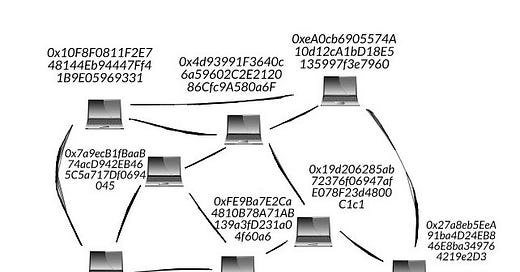02 - How the Island of Yap Works Today
Last week we learned about our friends on the Island of Yap. Their stone system, or Rockchain, serves as the blueprint for today’s blockchains. What might have dawned on many of you is that the system the Yapese were using would not work in today's world; having a ledger filled with people’s names and bank account balances is a receipt for disaster. The Yap system worked for the islanders because in the small remote South Pacific community, the people of Yap were more concerned with survival than they were about what Susie was spending her money on.
Blockchain solved some of the concerns with the stone system using a few cryptographic techniques.
Wallet addresses
In order to protect people’s identities, blockchain networks don’t require a participant to divulge any personal information when joining the network. You are not prompted to log in with Google or Facebook (now Meta?). Instead, when a participant joins the network they are assigned something called a wallet address. A wallet address is a long string of numbers and letters created at random and not connected to the wallet owner in any way.
How do you get a wallet address? It’s as easy as downloading a copy of the blockchain ledger to your computer and telling the rest of the network you have arrived. Once you do this, a wallet address will automatically be created.
Having a wallet address allows network participants to send and receive digital assets. It is like having an email address on the traditional internet. It gives someone sending you something a location to send it to. In the case of email, it is a message and in the case of a blockchain, it is some form of value.
Identifying users by a non descript address and not by name is ok because the only information that each participant needs to know is whether the person they are transacting with has the digital assets they claim to. A great real world analogy for transacting based on account balances is selling something at a yard sale. You don’t need to know anything about the person you are selling to. All you need to know is that they have enough cash in their wallet to make the purchase. They either have a $100 bill or they don’t.
Authorizing signatures
Due to their size, blockchain networks can’t authenticate transactions the same way the Yapese could. On Yap, it would have been easy for the rightful owner to connect with the whole island and prevent theft. The community would have checked their personal ledgers, voted, and verified the rightful owner. How does the blockchain network with millions of anonymous people spread across the globe know that a transaction is legitimate? It would be impossible for a participant to contact a majority of other blockchain participants and convince them of theft.
Blockchain networks solve this problem by validating each transaction through the use of signatures. Similar to the way people sign checks to authorize the release of money from their bank accounts, all blockchain transactions must be signed by the individual sending the digital asset. Instead of using handwritten signatures, blockchains use complicated math formulas ie. cryptography to generate an authorizing signature. Only the person who contracts a wallet address is able to sign an authorization to move an asset out of that wallet address.
Tying it all Together
Let’s take a step back and tie everything together.
A blockchain network, just like the Island of Yap stone system, is a distributed ledger system.
A copy of the ledger is stored on every blockchain participant’s computer.
Each participant is anonymous and only identified on the blockchain network through a wallet address.
Wallet addresses hide the participants identity by not revealing the owners personal information to the rest of the network.
Every time a transaction occurs, the person who is sending money tells the rest of the network how much they are sending and to which other wallet address.
The network reviews the transaction’s signature, confirms its authenticity and adds it to the ledger.
With some slight tweaks and a little coding, the Island of Yap system has now become a global financial network.
There is an important point worth repeating in all this, blockchains are the elegant combination of technology that has existed for thousands of years. We began with the Island of Yap, added the internet and sprinkled in some cryptography. All blockchains rely on some combination of these features to accomplish their goal, tracking online scarcity. What everyone needs to understand is that most of what is happening from a technical level on a blockchain is not new. We are using what has already existed in a novel way.
Next week we are going to dive one level deeper and talk about why the technology is called a blockchain. Understanding this concept will help us move further from the real world example of the Island of Yap to one in which a system like a blockchain can actually be structured.
Huge shout out to my collaborators from Foster: Cameron Zargar and Diana Hawk






